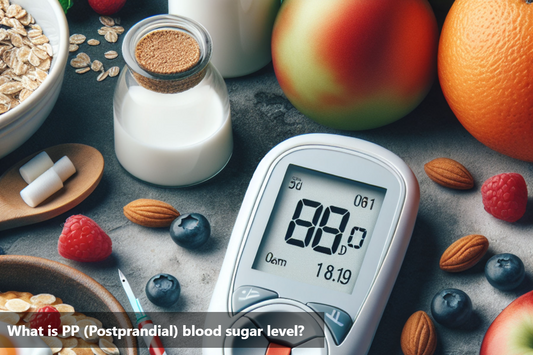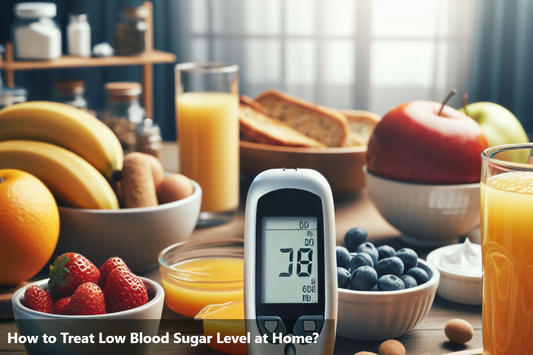A blood sugar checker, also called a glucometer, is a small and simple medical tool used to measure blood sugar levels. People with diabetes need to manage their health. Using this device, they can track their blood sugar at home and make smart choices about eating, exercising, and taking meds. Glucometers come in different types, from basic to more advanced digital ones with extra features for convenience and accuracy. Folks with diabetes need to have the best glucometer for keeping healthy. Brands like Caresens, GlucoSpot, and Glucocard offer reliable and easy-to-use options that cater to different needs.
These digital glucometers give fast and accurate readings, helping users stay on top of their diabetes care. With glucometer technology getting better, users now have access to free glucometers online and non-invasive ones that are more comfortable and convenient. These improvements show a strong commitment to making diabetes management and the lives of people with diabetes better. It's crucial to understand how to use a glucometer properly to make sure people with diabetes can monitor their blood sugar effectively and stay healthy.
Types of Glucometers
Glucometers are devices used to measure blood glucose levels in individuals. There are various types of glucometers available in the market, each with its own unique features and benefits.
Traditional Glucometers: These are the most commonly used type of glucometers. They require a small blood sample, usually obtained by pricking the finger, and provide a blood glucose reading within a few seconds.
Continuous Glucose Monitors (CGMs): CGMs are wearable devices that continuously monitor glucose levels throughout the day and night. They provide real-time glucose readings and can alert the user to high or low glucose levels.
Bluetooth-Enabled Glucometers: These glucometers can sync with a smartphone or other electronic devices, allowing users to track and monitor their blood glucose levels using dedicated apps.
No-Coding Glucometers: These glucometers do not require manual coding of test strips, which can simplify the testing process and reduce the risk of errors.
All-in-One Glucometers: Some glucometers come with additional features, such as built-in lancets for blood sampling, integrated test strip drums, and illuminated display screens for easier reading.
Each type of glucometer has its own advantages and limitations, and the choice of glucometer depends on individual preferences, lifestyle, and healthcare needs.
How to Use a Glucometer Machine
To obtain accurate readings and effectively manage diabetes, it is crucial to understand the proper technique for using a glucometer machine. Here is a step-by-step guide to help you through the process:
Prepare the Equipment: Ensure that the glucometer, test strips, lancet device, and unused lancets are ready for use. Check the expiration date of the test strips before proceeding.
Wash Your Hands: Thoroughly clean your hands with soap and water, and dry them well. Avoid using alcohol-based sanitizer as it may interfere with the reading.
Insert the Test Strip: Carefully insert the test strip into the glucometer, ensuring it is properly aligned. The machine will usually turn on automatically.
Lance Your Finger: Use the lancet device to prick the side of your fingertip. Gently squeeze to produce a small drop of blood.
Apply the Blood Sample: Touch the edge of the test strip to the blood drop and wait for the glucometer to display the result.
Record the Reading: Once the reading is displayed, record it in your logbook or the glucometer’s memory, if applicable.
Common Mistakes to Avoid:
Using an expired test strip
Not applying enough blood to the test strip
Hasty or inaccurate recording of readings.
By following these steps and avoiding common mistakes, you can effectively use a glucometer machine to monitor your blood glucose levels, ensuring better management of diabetes.
Always refer to the user manual of your specific glucometer model for detailed instructions.
Understanding Glucometer Readings
Monitoring blood sugar is really important for people with diabetes. Glucometers help to check blood sugar levels. The results show how the body reacts to food, exercise, and medicine. Glucometers measure blood sugar and show the results in milligrams per deciliter (mg/dL) or millimoles per liter (mmol/L). It's crucial to understand these readings to know if the blood sugar levels are in the right range. If the readings are high or low all the time, it could mean there are health issues that need quick attention and may require changes in treatment plans.
The accuracy of glucometer machines is really important for reliable readings. Lots of research and new technology have made glucometers more reliable. New models, including non-invasive ones, show that there are constant efforts to make them better. These new options give people with diabetes more choices to pick the right glucometer for their lifestyle. This means that in the future, glucometer technology will continue to get better, providing users with more accuracy and convenience.
Benefits of Glucometers
Glucometers are invaluable tools for managing diabetes. They offer several significant benefits, including:
Accuracy: Glucometers provide accurate and precise readings of blood glucose levels, enabling individuals to monitor their condition effectively.
Convenience: These devices are portable and easy to use, allowing users to check their blood sugar levels wherever they are, providing convenience and flexibility.
Improved Monitoring: Regular use of glucometers enables users to track their blood glucose levels over time, providing valuable insight into their condition and helping them make informed lifestyle and treatment decisions.
Early Detection: Glucometers help in the early detection of high or low blood sugar levels, enabling prompt intervention and avoiding potential health complications.
Empowerment: By using a glucometer, individuals with diabetes can take an active role in managing their health, leading to a sense of empowerment and control over their condition.
The Future of Glucometer Technology
The technology for measuring blood sugar levels has improved a lot, especially with non-invasive glucometers. These new devices are designed to make it easier and less painful for people with diabetes to check their blood sugar. They don't need to prick their fingers, which makes it more comfortable and less invasive. This could encourage people to check their blood sugar regularly.
Glucometers are now available to buy online, which makes it convenient for people to get them. Brands like Caresens, GlucoSpot, and Glucocard offer online purchase options to make them more accessible. There are also programs where people can get a glucometer for free, so that more people can have access to this important tool for managing diabetes.
The new digital glucometers are more accurate and have better features, which means they provide reliable and quick results. These improvements show that glucometer technology is getting better and offer hope for better diabetes management.
It's important to keep an eye on new developments in glucometer technology to make sure people get the best and most effective ways to monitor their blood sugar.
FAQs:
Q: How often should a glucometer be calibrated?
A: Most glucometers do not require frequent calibration; however, it is recommended to check for accuracy periodically.
Q: Can a glucometer be used for multiple people?
A: It is not advisable to share a glucometer with others. Each person should have their own device to avoid cross-contamination.
Q: What should I do if my glucometer displays an error message?
A: In case of an error message, refer to the instruction manual or contact the manufacturer for troubleshooting steps.
Q: Is it necessary to use special test strips with a specific glucometer model?
A: Yes, each glucometer model requires compatible test strips. Using the wrong strips may lead to inaccurate readings.
Q: How should I dispose of used lancets and test strips?
A: Used lancets and test strips should be disposed of in a puncture-resistant container following local disposal regulations.
This Blog post is an initiative by DiabeSmart, to provide accurate and Nutritionist / Doctor approved information related to Diabetes. DiabeSmart is India's first Food brand designed specifically for Diabetics, that has been clinically tested on Diabetics and Pre-Diabetics to deliver 55% - 70% lower Sugar spikes. DiabeSmart is part of Lo! Foods - India's leading brand for Everyday Functional Health foods.











